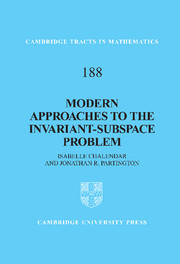Book contents
- Frontmatter
- Contents
- Preface
- 1 Background
- 2 The operator-valued Poisson kernel and its applications
- 3 Properties (An,m) and factorization of integrable functions
- 4 Polynomially bounded operators with rich spectrum
- 5 Beurling algebras
- 6 Applications of a fixed-point theorem
- 7 Minimal vectors
- 8 Universal operators
- 9 Moment sequences and binomial sums
- 10 Positive and strictly-singular operators
- References
- Index
1 - Background
Published online by Cambridge University Press: 07 October 2011
- Frontmatter
- Contents
- Preface
- 1 Background
- 2 The operator-valued Poisson kernel and its applications
- 3 Properties (An,m) and factorization of integrable functions
- 4 Polynomially bounded operators with rich spectrum
- 5 Beurling algebras
- 6 Applications of a fixed-point theorem
- 7 Minimal vectors
- 8 Universal operators
- 9 Moment sequences and binomial sums
- 10 Positive and strictly-singular operators
- References
- Index
Summary
In this chapter we begin by reviewing the main definitions and theorems from the basic theory of functional analysis, linear operators and geometry of Banach spaces. It is not our intention to summarize the whole of analysis within a few pages, but we do supply the necessary background to the results used later in the book. This material is very standard and likely to be met in any basic course on functional analysis, and so we give just the essentials of the subject, without proofs.
In the last sections of this chapter, we also recall some basic facts of function theory. In particular we discuss the fundamental properties of Hardy spaces, which are Banach spaces of holomorphic functions defined in the unit disc and extended to the unit circle T. We also briefly review the definitions of the disc algebra, functions of bounded mean oscillation, and the Hilbert transform of real functions defined on the unit circle.
Functional analysis
Weak topology
The term weak topology is most commonly used for the topology of a normed vector space or topological vector space induced by its (continuous) dual.
One may call subsets of a topological vector space weakly closed (respectively, compact etc.) if they are closed (respectively, compact etc.) in the weak topology. Likewise, functions are sometimes called weakly continuous (respectively, differentiable, analytic etc.) if they are continuous (respectively, differentiable, analytic etc.) in the weak topology.
- Type
- Chapter
- Information
- Modern Approaches to the Invariant-Subspace Problem , pp. 1 - 36Publisher: Cambridge University PressPrint publication year: 2011

